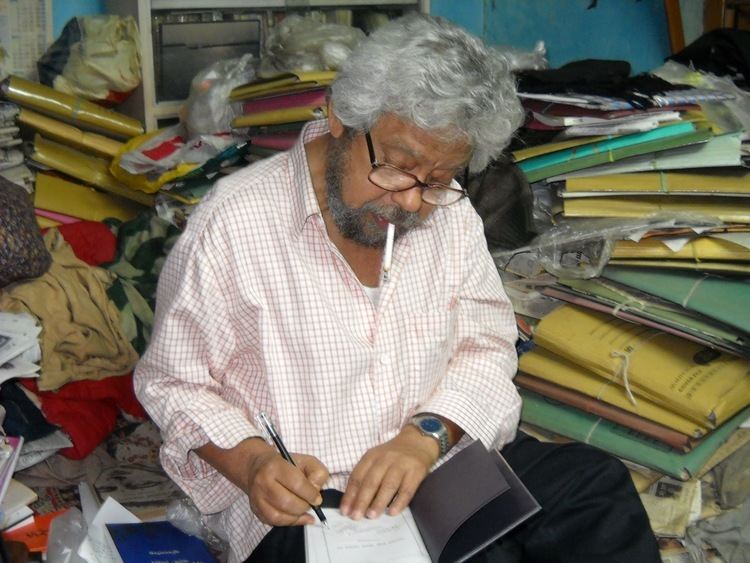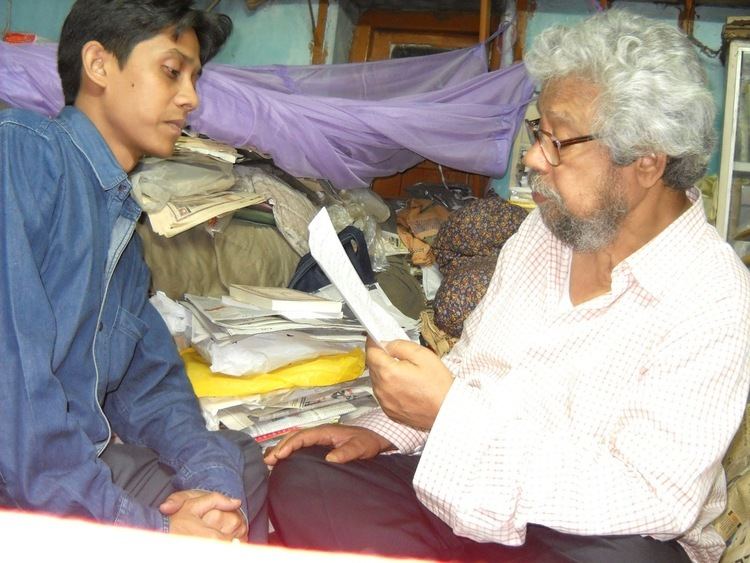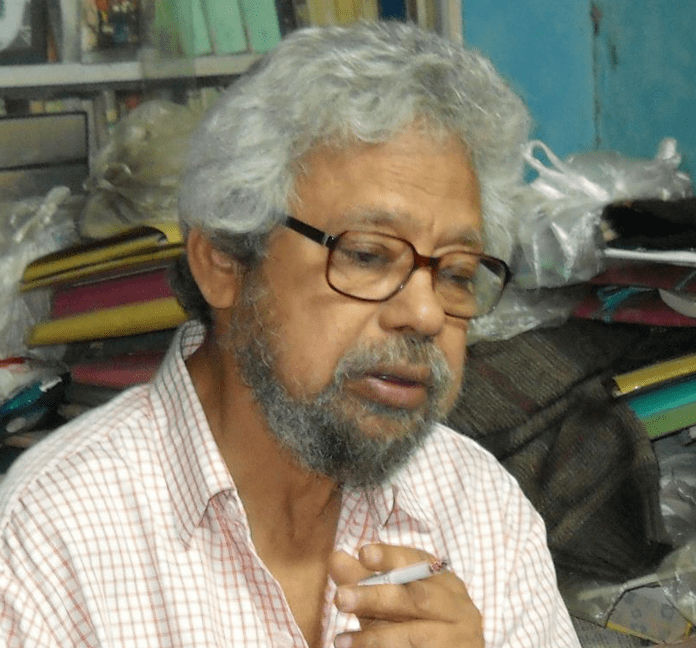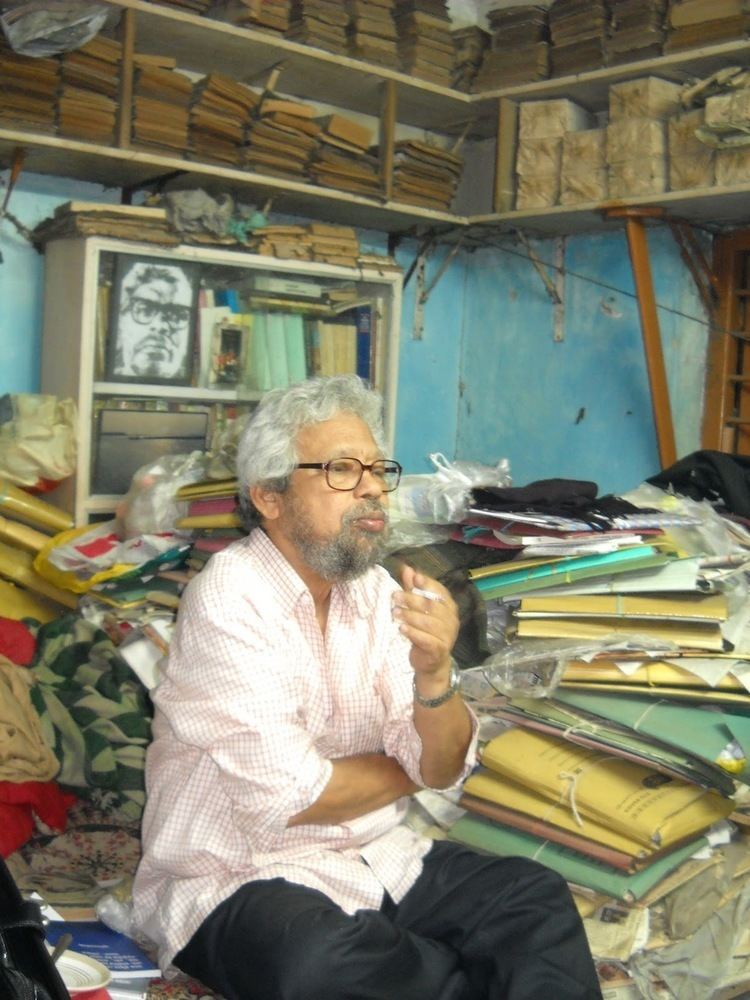Name Subimal Mishra Role Novelist | ||
 | ||
Born 20 June 1943 ( 1943-06-20 ) Books The Golden Gandhi Statue from America Similar People Banksy, Alberto Giacometti, Ritwik Ghatak, Samuel Beckett, Jean‑Luc Godard | ||
Underground a film on subimal mishra
Subimal Misra (born 1943) is a Bengali novelist, short story writer and essayist. He is known as a maverick and audacious experimentalist in contemporary Bengali literature. Many of contemporary writers are Misra's fans and inspired by Misra's writings. Misra is recognized as the most important writer in Bengali in the field of little magazine.
Contents
- Underground a film on subimal mishra
- underground dvd 3hr 28 min
- Works
- Fictions
- Non fictions
- Themes
- Styles
- Use of visual elements in writing
- Influence
- References

Subimal Misra started his literary career at the end of 1967. From then on, he is writing only in Bengali Little Magazines and has never penned a single word for any commercial magazine. Strong critique of the complacent and decadent bourgeoisie, his writings are starkly political. His use of calligraphy, space and visually expressive letterings gives a new dimension to his writings.

Heavily influenced by Jean-Luc Godard, Subimal Misra uses various cinematic techniques, like montage, jump-cut etc., in his literary works. And Godard mentioned him as 'Godard of literature'.

Subimal Misra currently lives in Shampa Mirza Nagar, Kolkata. Though he is suffering from serious heart disease, he still writes regularly and keeps himself up-to-date with recent developments in the world literature.

underground dvd 3hr 28 min
Works
To date, Subimal Misra has published over 20 volumes of stories, novels, novellas, non-fictions and plays. Most of these volumes are conceptualized, designed, printed and published by the author himself.
Fictions
Subimal Misra's early works, published in various little magazines, instantly attracted the attention of readers and critics alike due to their sheer experimental forms and controversial subjects. One of his early short stories "Haaraan Maajhi-r Bidhabaa Bou-er Maraa baa Sonaa-r Gandhimurti" (The Corpse of Haaraan Maajhi's Widow or the Golden Statue of Gandhi), met with huge critical applause in its first appearance. After the publication of this story, Kamal Kumar Majumdar and Amiya Bhushan Majumdar, two stalwarts of alternative Bengali literature, congratulated and encouraged him to continue writing. After that, he took writing as a serious vocation. During this time, he wrote some of his most acclaimed stories—"Baganer Ghoraanim-er Gaachh-e Dekhonchacha Thaakten" (Uncle Seer Used to Live on the Ghoraanim Tree in the Grove), "Ut" (The Camel), "Chhuri" (The Dagger), "Porijaatok" (Descendant of an Angel) and "Nuye-Guye Dui Bhai" (Nuye and Guye are Two Brothers).
His later short stories include-- "Nangaa Haar Jege Uthchhe" (Naked Bones are Waking Up), "Calcutta Dateline", "Satitwa Ki Raakhbo Aparna?" (Aparna, Should I Keep My Virginity?), "Nikat Probishto Samporkeo Dharankshamotaa" (The Ability to Hold the Closely Penetrated One), "Mati Nore" (The Earth Trembles) and many more. Most of these stories are included in the collection "36 Bachhor-er Rograrogri" (Haggles of the Past 36 Years)
Subimal Misra uses the words "anti-novel" and "anti-story" to differentiate his works from the traditional narrative fictions. His first anti-novel "Aasole Eti Ramayan Chamar-er Golpo Hoye Uthte Paarto" (It could have been Ramayan Chamar's Story), published in 1984, though centred on and around a fictitious character called Ramayan Chamar, is actually the story of creating a story, a metafiction. This novel, set against the tumultuous political scenario of West Bengal in the 70's, strongly attacks the aimlessness of today's political thoughts and their bigotry.
He wrote two other "Anti-Novels" in this period-- "Rang Jakhon Satarkikaron-er Chihno" (When Colour is the Symbol of Danger), published in 1984 and "Kantha Palak Ora-- Sabkichhui" (The Featherd Neck—Everything), published in 1990. These two, along with "Ramayan Chamar" constitute a trilogy which explores the inevitable decadence of urban middle-class.
His later anti-novels are more cryptic and chaotic in nature. These works include-- "Satya Utpaadito Hay" (Truth Gets Manufactured), "One Pice Father Mother" (A Penny is my Father and Mother), and "Chete-Chushe-Chibiye-Giley" (Lick-Suck-Munch-Gulp).
He has published two books in their manuscript form, reproduced by photocopying -- "Harmormori" (Clatter of Bones) and "Gu-er Pnod Tin Jaygaa-y Laage" (Shitty Bum Touches in Three Places). These two books employ extensive graphical and visual elements in their structures. Language and image are inextricably intermingled here to produce an archetypal and tortuous view of our existence.
He has also written a play-- "Vito Pnatha-r Istoo" (Stew of Brother Goat).
Non-fictions
Though it is often difficult to demarcate between fiction and non-fiction in Subimal Misra's works, he has published two complete volumes of non-fictions in which he has elaborated on his ideology and stance as a writer. One of these two volumes, "Sun and Murderer", is a collage of his own essays, letters, medical reports and entries from his journal as well as other people's comments on his writings, criticisms and book-reviews. The other collection is titled as "Subimal-er Biruddhe Subimal" (Subimal Against Subimal) which highlights not only his commitment as an anti-establishment writer, but also the contradiction inherent in it. In Bengali literature the writers who are considered to be of the same anti-establishment school are the Hungryalists such as Basudeb Dasgupta, Subhas Ghosh, Malay Roy Choudhury, and Arunesh Ghosh.In fact, the Hungryalists were the first post-colonial generation to vent their anti-establishment voice of libertad in pre-planned narratives. Though Subimal Misra was never a part of the Hungryalist Movement, there are some common elements (like, anti-establishment and anti-narrative stance) of Hungryalism visible in his works as well.
Themes
Misra's works are essentially anti-establishment and blasphemous in nature. He questions and thereby disturbs our complacence as readers. According to him, his works remain incomplete without the active participation of his readers. Starting from the titles of his books, he tries to destroy all the traditional and preconceived notions about art and literature. To disavow the concept of establishment and consumerism in art, he himself publishes and distributes his own books.
Along with politics, Sex is an important and recurring subject in Misra's works. Throughout his writings, he tries to reveal the matriarchal past of human society by deconstructing the chauvinistic elements, various forms of sexual dominance and discriminations. Sex, according to him, is a weapon in this consumerist society, at once repressed and liberated. He uses the form of pornography, stressing on the subversive aspects of it, to explore the socio-political forces behind the concepts of sex and sexuality in modern society.
Styles
His more recent works are entirely devoid of any narrative. They are, cumulatively, a vast and ingenuous collage of newspaper clippings, essays, and excerpts from his journal and letters. Beyond this apparently chaotic form, there lies a deeper representation of the decadence of human civilisation. According to Subimal Misra, this form is essentially important in today's world because of its inherent ‘plurality’. It opens up a discursive field within the readers’ minds—at once contradictory and concurrent. "One Pice Father Mother" (A Penny is my Father and Mother), and "Chete-Chushe-Chibiye-Giley" (Lick-Suck-Munch-Gulp) are good examples of his extremely anti-narrative stance.
Use of visual elements in writing
Apart from collage (or, Montage, borrowing the term from film) and cut-ups as writing techniques, Subimal Misra amply uses calligraphy, innovative letterings and graphics in his writings. Such evocative usage of visuals is a means of provoking and stimulating the readers, and creating new meanings out of those mundane words. Often, in Misra's works, two or more paragraphs are merged, thereby creating two separate texts running parallel to and colliding with each other.
Influence
To some extent, Subimal Misra's works resemble those of William S. Burroughs. Like Burroughs, Misra also uses a technique similar to cut-up. At the same time, he acknowledges the influence of James Joyce, Jean-Paul Sartre, Kathy Acker, Samuel Beckett and even, Kurt Vonnegut on his works. He is also influenced by various filmmakers and their works, most notably, Jean-Luc Godard, Andrei Tarkovsky, Luis Buñuel and Ritwik Ghatak.
